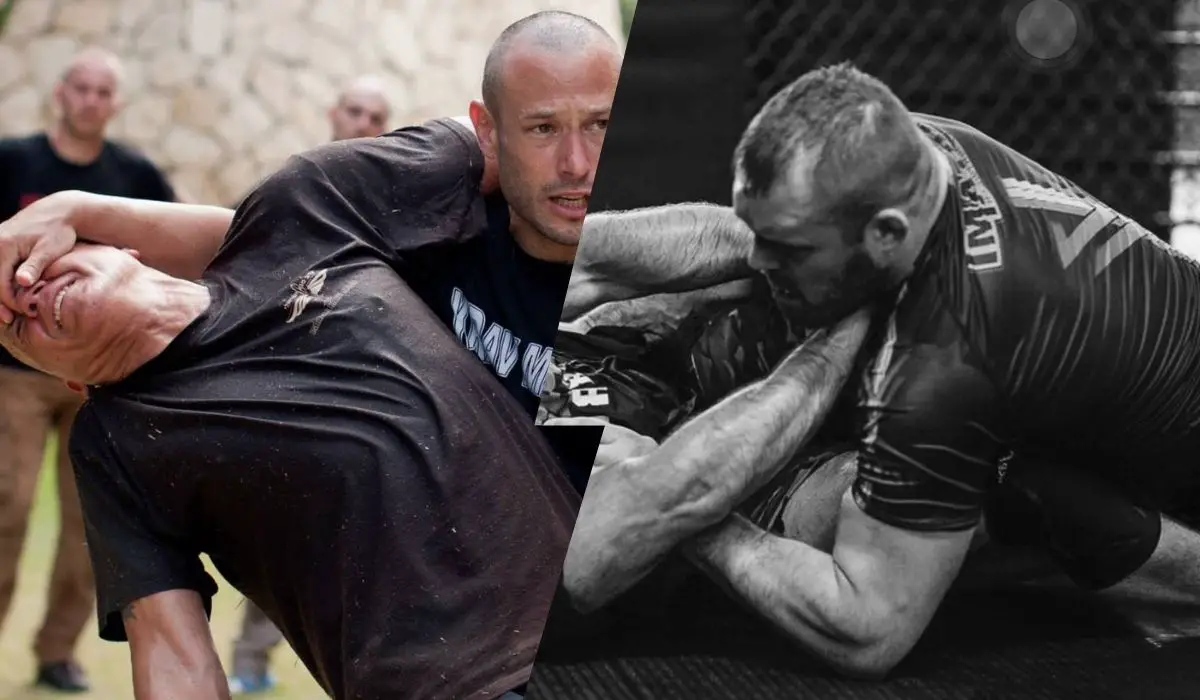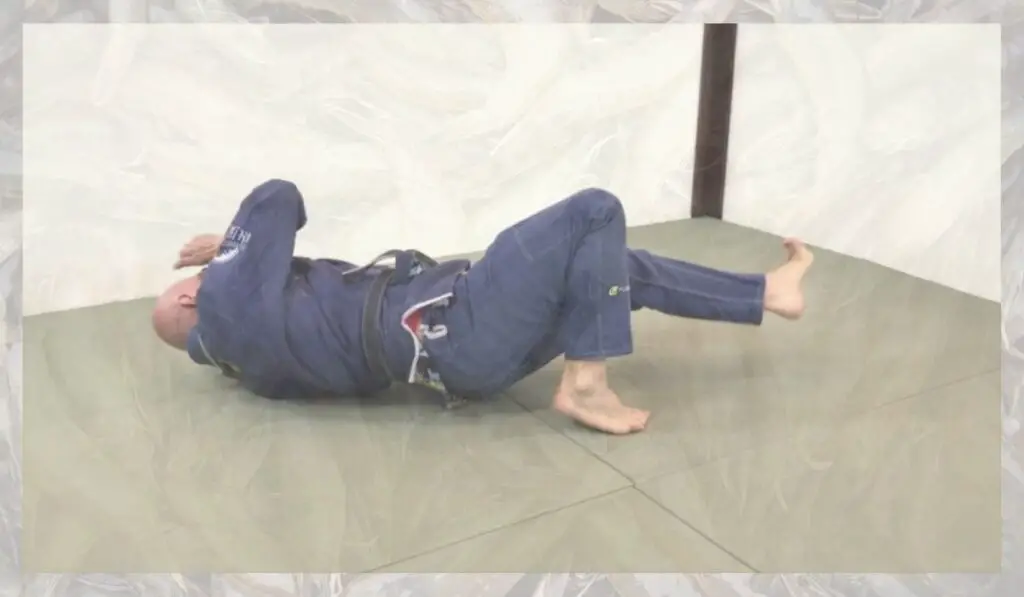Krav Maga and Brazilian Jiu-Jitsu are excellent combat fighting disciplines with many global following. However, there are so many differences between BJJ and Krav Maga – philosophy, footwork, stance…
Nowadays, BJJ is one of the most popular grappling martial arts. High-level Brazilian jiu-jitsu fighters can finish you from every single position on the bottom. On the other hand, the ultimate goal of Krav Maga is to disable your enemy by any means necessary.
But if somebody says “Which one is better, BJJ or Krav Maga”, what would you say? Can you compare these two fighting styles? Can BJJ work better on the ground? After all, Krav Maga allows nut shots, eye gouges, and throat strikes!
Please read on to get to know which martial art gets the advantage! There will be many examples in this article!
Is There a Difference Between BJJ and Krav Maga?

Oh yeah, there are so many different aspects of the game. We’re comparing a grappling martial art with a self-defense fighting style. We will list all differences, step-by-step:
- You mustn’t strike, slam or eye gouge your opponent in a BJJ fight. Spine submissions and some joint locks are prohibited too. In Krav Maga, there are no illegal moves, you can do whatever you want.
- BJJ is a competitive martial art, but there are no competitions in Krav Maga.
- Krav Maga focuses on neutralizing the threat by targeting the weak spots of his body and finishing the bout as soon as possible. However, BJJ is based on the ground game and clinches submissions. You’ll need more time to end a jiu-jitsu fight.
- BJJ targets major competitions, a strict rule set, and popularity (it doesn’t work well against multiple foes). However, Krav Maga focuses exclusively on self-defense.
- Krav Maga is a no-gi martial art. The coaches put you into the fire right off the bat, your training partners wear everyday clothes (t-shirt, jacket, hoodie…). In BJJ, there are gi and no-gi training sessions.
- No weight classes in Krav Maga. There is open-weight combat in BJJ, but weight generally matters, there are several weight divisions.
- You’ll hardly defeat an armed thug even if you’re a BJJ black belt. Yet, Krav Maga focuses on dealing with all kinds of enemies.
- Krav Maga experts stay away from submission switches, while you’ll see those kinds of actions very often in BJJ tournaments or training sessions.
BJJ Vs Krav Maga, Which Is The Best Fighting Style?
Well, if you plan to compete and win medals, BJJ rocks. You can get public recognition, earn medals, and become famous.
Do you plan to defend against a very tall or super-strong bully? BJJ could help, but Krav Maga works better for sure. The Israeli martial art is also way better for neutralizing multiple attackers or armed thugs.
Krav Maga Vs BJJ, Which Is Better for Beginners?
It depends on your goals. Krav Maga is way easier to learn. If you plan to defend yourself quickly, Israeli martial art should be your pick. You will learn to deal with all kinds of foes, plus more advanced dojos offer armed combat lessons.
Krav Maga is an excellent choice for somebody who’s been bullied for a prolonged time. If you’ve never fought before, you’ll learn dirty shots and the basics of self-defense in a split second.
On the other hand, BJJ takes time to master. For example, you can’t learn to pass guard overnight. Even the most basic technique, a rear-naked choke, is a bit harder to accomplish.
Why? Well, you need a lot of power to force your enemy to surrender when your hand is not under the chin (then RNC turns into a neck crank).
You can lock the body triangle tight too, but there are many ways to defend using Brazilian jiu-jitsu. A skillful opponent will raise the hips off the mat, decreasing the distance between his heels and glutes.
Although, you’ll have a hard time ending the fight, despite, for example, the back mount giving you so many options.
In BJJ, you must take your enemy down before attempting to finish the fight in more than 90% percent of cases. It is hard to take a very heavy opponent down, even with the best technique in the world.
Should I Learn Both Krav Maga and BJJ for MMA?
Krav Maga works in the street, but it is not the best choice for the MMA bout. It was excellent for the first seven UFC events, as nut shots, throat strikes, headbutts, and elbows to the back of the head were perfectly legal (eye gouges and biting have always been fouls).
Yet, rules changed, and mixed martial arts were turned into a sport with a strict ruleset. Krav Maga could help, but it is not recommended for an MMA battle.
Nowadays, there are minor differences between MMA promotions. But when the competitions take place under UFC rules, you mustn’t kick or knee grounded opponent, grab his shorts or fence (ropes), hit him to the back of the head…
There are so many fouls, so a Krav Maga expert would have been disqualified in the first round. The first foul is a warning, then comes a point deduction.
Make four fouls and you’re out of the game (if you make a too-big foul, your first offense could lead to a red card and disqualification).
BJJ is an excellent choice when you combine it with striking martial art. The proof of this theory is Royce Gracie, the first-ever UFC champs who submitted so many Goliaths.
Related: Jiu-Jitsu Vs Kickboxing Which Is Better?
The only downside of BJJ on the ground is going head-to-head with Dagestani wrestlers, as they are masters in passing guard and top control.
Look at the bout between the former lightweight champ Khabib Nurmagomedov and BJJ black belt, the ex-155-pound division belt owner Rafael dos Anjos.
Source: UFC – Ultimate Fighting Championship
The second problem happens when your opponent keeps the fight standing. Masters of jiu-jitsu lack striking skills. Please watch Demian Maia’s or Ryan Hall’s bouts – they are very poor strikers.
Overall, BJJ works better for an MMA battle. But it will work in the clinch or as soon as you drag your foe to the ground. The modified version of Krav Maga (adjusted to MMA rules) is better for the stand-up game.
Krav Maga Vs Brazilian Jiu-Jitsu, Which Is Better for Self-Defense?
We have already described three major problems of BJJ in the street fight – dealing with multiple opponents, takedown offense, and defeating armed thugs.
Other than that, BJJ works well in a 1-on-1 battle. Weight class doesn’t play a major role, street bullies usually don’t know to defend against submission attempts and switches.
There are no downsides to Krav Maga in the street. Your opponent can carry a knife, a club, or even a gun, the dojo teaches you all kinds of self-defense techniques. The master of Israeli martial art attacks your vital spots and finishes the bout in less than 5 seconds.
Krav Maga experts will try to keep the fight standing and use other attackers as a shield in, for example, 1 on 3 fights. It is a way better choice for self-defense and street battles.
Related: Martial arts may be an excellent tool for self-defense in any scenario. Click here to discover the most efficient martial arts techniques and training methods for keeping yourself safe and secure.
Which Is Better for Law Enforcement, BJJ or Krav Maga?
Cops sometimes have to deal with drugged or drunk individuals. Those people cannot control their actions, so any skill can come in handy.
Here is an example of a BJJ cop who used his skillset to control the larger suspect. You can see a successful takedown attempt off the back and fabulous control off the mount.
But let’s be honest, this suspect had zero ground skills.
Law enforcement mostly gives an advantage to Krav Maga as it is way easier to apply. Criminals mostly try to evade prison by any means necessary. Sometimes they attack cops to stay free.
Krav Maga teaches you to react in all kinds of situations. If you’re a cop, you’ll have greater chances of apprehending the suspect and neutralizing the threat, so it is a better choice for street situations.
Look at the concept of weapon retention drills. You don’t learn this in a BJJ class!
Combining Krav Maga and BJJ, Is It Good?
Yes, there are many self-defense benefits on both sides. Krav Maga teaches you to react in the stand-up, while BJJ protects you on the ground. Your defensive skills will rock!
If you plan to transition to MMA, this combination might not be the best choice. First, referees don’t like illegal strikes.
Second, Krav Maga doesn’t like lateral moves – when you don’t move inside the Octagon, the opponent will trap you against the fence and win via cage control.
Third, it is hard to shoot in from a Krav Maga stance, you’ll have to make significant fighting style modifications.
Do BJJ and Krav Maga Have Similar Belts Ranking Systems?
Well, there are more differences than similarities. The red belt symbolizes the highest level of BJJ (black belt in Krav Maga).
You’ll need 10 years of BJJ training to reach black strap, while a die-hard Krav Maga practitioner might reach the greatest level of knowledge in just 3 years!
Here’s the belt system in the Israeli martial art:
- Yellow (Level 1).
- Orange (Level 2).
- Green (Level 3).
- Blue (Level 4).
- Brown (completion of Level 5).
- Black (level 6, the highest belt is 8th dan – chief Instructor Darren Levine).
Look at the BJJ’s order of progression and the list of belts below:
- White belt.
- Blue belt.
- Purple belt.
- Brown belt.
- Black belt.
- Coral Belts: Red/black belt and Red/white belt.
- Red belt.
BJJ is harder to learn. You’ll need more time to change the color of your belt.
Final Thoughts
Krav Maga and BJJ are very different fighting styles. BJJ focuses on competitions and legal/illegal moves, while the masters of Israeli martial art can disarm or defeat all kinds of enemies in a split second.
Here is a brief recap of the positive and negative sides, differences, and similarities between BJJ and Krav Maga:
- Krav Maga is way more efficient for self-defense and street fighting.
- BJJ is a sports discipline, and Krav Maga is a self-defense system without rules.
- The greatest similarity between BJJ and Krav Maga is the lack of footwork. BJJ fighters tend to shoot in and drag the bout to the ground, while Israeli martial art focuses on straight-line counters and disabling the opponent.
- There are belts in both martial arts, but the ranking system is different.
- Krav Maga is easier to master, you must train BJJ for a long time before getting a high-level belt.
- BJJ is better for MMA, you’d have to modify Krav Maga strikes for a successful mixed martial arts career.
We hope you understand the advantages and downsides of these two martial arts. Would you like to focus on self-defense or do you plan to take part in the competitions? Which one are you going to choose and why?



